What Is Kamino Finance?
Kamino Finance is a Solana-based concentrated liquidity management tool that integrates lending, liquidity, and leverage into a unified DeFi product suite. This allows users to borrow and lend assets, provide leveraged liquidity, build automated liquidity strategies, and use concentrated liquidity positions as collateral.
Key Takeaways
-
Kamino Finance is a Solana-based concentrated liquidity management tool that enhances capital efficiency by allowing liquidity providers to allocate assets in specific price ranges.
-
It combines lending, liquidity provision, and leverage, allowing users to engage in multiple financial activities on one platform.
-
Product suite includes features like Borrow and Lend, Multiply Vaults, Long/Short Vaults, Liquidity Vaults, and a DIY Vault Creator.
-
Offers yield-bearing LP tokens (kTokens) and a lending protocol with efficient loan-to-value ratios.
-
Kamino Points is a reward system that enhances user engagement and loyalty.
-
KMNO tokens, the protocol's governance token, will be distributed via airdrops based on Kamino Points earned by users through various platform activities.
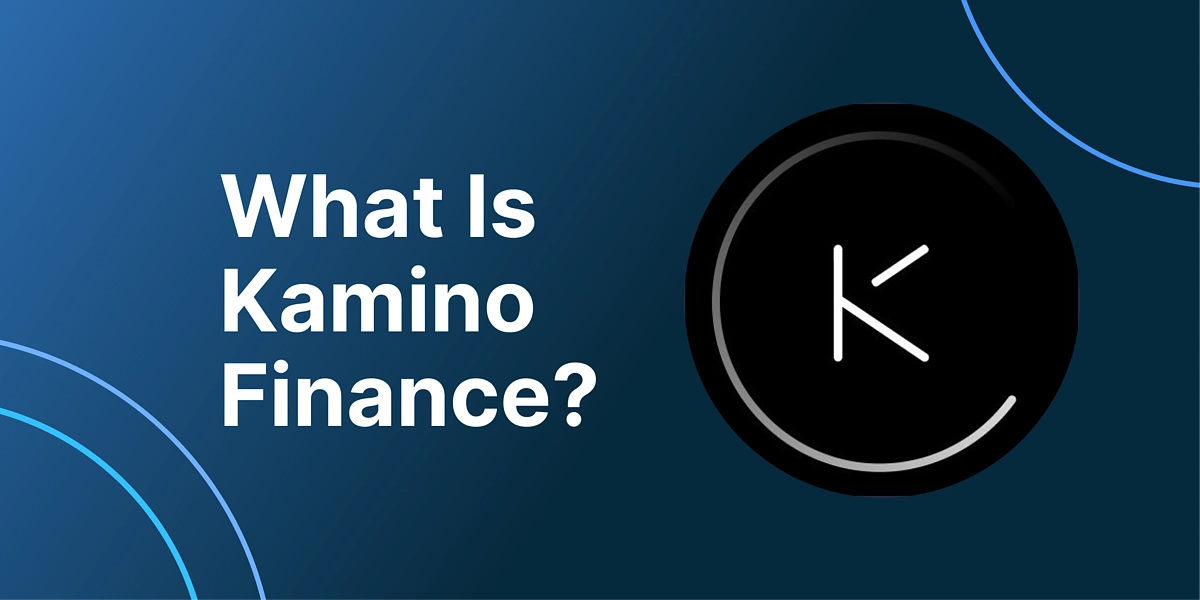
In traditional Automated Market Makers (AMMs), liquidity providers (LPs) deposit assets into a liquidity pool, which are then used to facilitate trades on the platform. This liquidity is spread across the entire price range for the trading pair. However, in a concentrated liquidity system, LPs can choose specific price ranges within which to allocate their liquidity.
A concentrated liquidity layer, thus, helps in optimizing capital efficiency.
Uniswap V3 is the most popular concentrated liquidity platform in the Ethereum ecosystem. In the Solana ecosystem, Kamino Finance is rallying in popularity, with over $836 million in TVL based on DefiLlama data at time of writing.
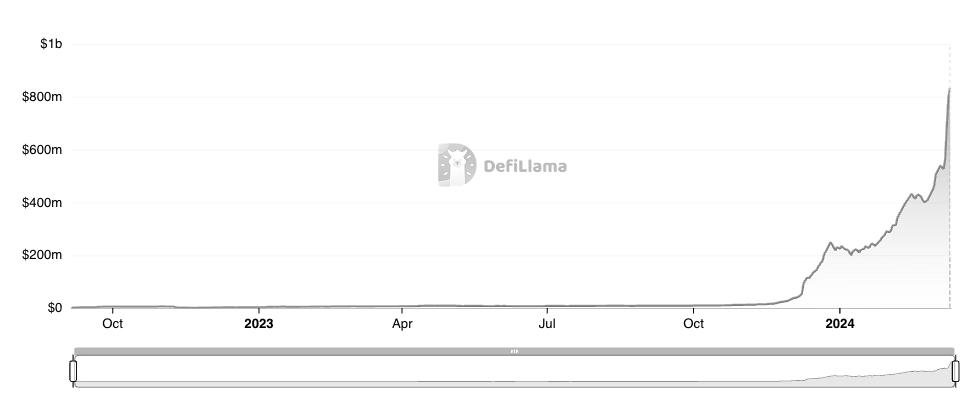
In this article, we will explore what Kamino Finance is, its key features, how to get started and how you can earn Kamino Points.
Kamino Finance: Solana's Liquidity Destination
In decentralized exchanges (DEXs), trade volume plays the biggest role in determining a dApp’s revenue. In conventional AMMs, the even distribution of liquidity across the entire price range often leads to capital inefficiency, especially in price ranges where trade volume is low. This is because liquidity that is locked in less active price ranges is not being effectively utilized to earn fees from trading.
Concentrated liquidity management, as implemented by Kamino Finance and the like, addresses this issue by allowing liquidity providers to allocate their assets in specific price ranges where they expect more trading activity. This targeted approach ensures that liquidity is concentrated in ranges with higher trading volumes, leading to more efficient use of capital.
Kamino Finance, in particular, stands out in the Solana ecosystem for its approach to concentrated liquidity. It offers automated tools and strategies to help LPs optimize their positions within the liquidity pools, making it easier to manage the complexities that come with concentrated liquidity provision.
Further, the platform allows users to borrow and lend their assets and also provide leveraged liquidity to concentrated liquidity DEXs. With Kamino, users can also build their own automated liquidity strategies and use concentrated liquidity positions as collateral.

The product suite includes:
-
Borrow and Lend for supplying assets to earn yield and borrow against collateral.
-
Multiply Vaults for boosting SOL yields up to 10x.
-
Long/Short Vaults for Increasing Exposure with a single simple, one-click leverage.
-
Liquidity Vaults for automated LP strategies and earning fees/rewards by deploying liquidity into DEXs.
-
DIY Vault Creator for custom LP strategies.
Kamino Finance consists of four essential primitives, which we'll delve into in the sections below:
-
Automated Liquidity Vaults
-
Kamino Lend (K-Lend)
-
Multiply
-
Long/Short
Automated Liquidity Vaults
Kamino's first, Automated Liquidity Vaults, is a leading liquidity provider (LP) primitive on Solana. Kamino liquidity vaults issue yield-bearing LP tokens, “kTokens” to depositors, which are accepted as collateral in K-Lend.
The kTokens lay the foundation for powerful DeFi strategies, like leveraged liquidity provision, or delta-neutral liquidity provision. These kTokens can also be used in other DeFi applications (for example, as collateral in K-Lend), where users continue receiving the yield from the LP position.
Kamino's automated liquidity vaults allow users to earn yield on their crypto assets by offering liquidity to concentrated liquidity market makers (CLMMs).
A Kamino vault uses liquidity in an underlying DEX pool, consisting of two tokens. When users deposit into a vault, they can earn fees from trading volume. Kamino Finance automates the entire LP process to provide optimal capital efficiency and yields using automated position rebalancing, auto-compounding trading fees as well as additional incentive and auto-swap for single-sided deposits/withdrawals.
K-Lend
K-Lend (short for Kamino Lend) is a lending protocol that operates on a peer-to-pool basis and is unifies borrowers, lenders, and liquidity providers. Think of it as a “decentralized matchmaker” between lenders and borrowers of crypto assets.
One of the standout features of K-Lend is its "Elevation Mode," inspired from Aave’s Efficiency Mode; it allows users to borrow highly correlated or soft-pegged assets at more capital-efficient loan-to-value (LTV) ratios.
In simpler terms, it groups together assets that are similar or have similar values (like different types of stablecoins) and sets rules for borrowing against them. This setup allows users to borrow more money compared to the value of their assets than they normally could. It's like getting a bigger loan for the same amount of collateral.
K-Lend also implements a poly-linear interest rate curve, offering a more gradual adjustment in interest rates compared to traditional lending platforms. This nuanced approach aids in maintaining market equilibrium and providing flexibility for borrowers.
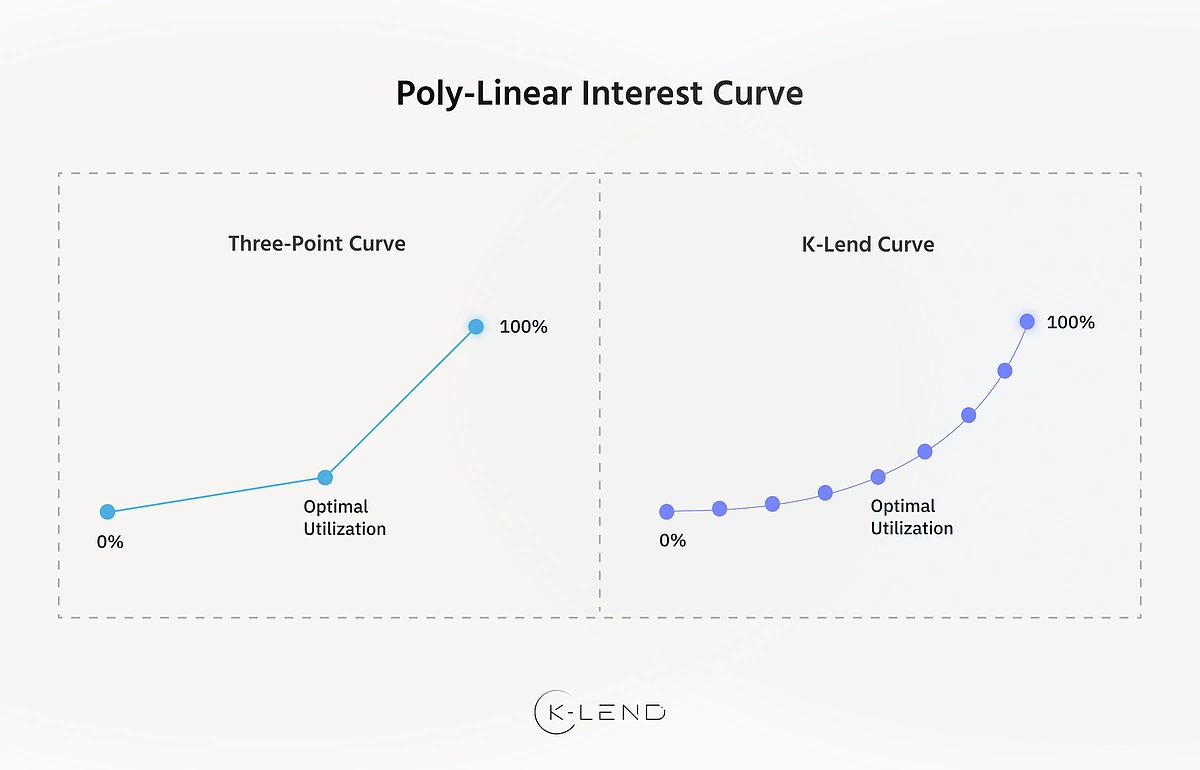
K-Lend has various salient features that allows capital efficiency, and has a sophisticated risk engine to protect both borrowers and lenders.
The K-Lend interface includes the following:
-
List View: To get an overview of lending pool.
-
Market Page: To get a detailed overview of the market for each asset in K-Lend.
-
Loan Dashboard: To get an overview of a user's position.
-
Risk Analysis: To simulate market movement impact on your loan.
Multiply Vaults
Multiply Vaults are designed to amplify users' exposure to specific yield-bearing assets by enabling leveraged positions. Essentially, they allow users to open leveraged positions to increase their exposure to certain assets.

For instance, a user can enhance their exposure to a yield-bearing asset like JitoSOL by borrowing SOL. This leverage is facilitated through K-Lend mechanisms. As long as the yield on the yield-bearing asset is higher than the borrow APY, users will enjoy a positive net APY (and a corresponding increase in SOL balance).
The yield in Multiply Vaults comes from two main sources – staking yield from LST tokens such as mSOL, JitoSOL, bSOL, and market-making yield from kTokens via trading fees in Kamino liquidity vaults. Some vaults combine both these sources, providing a diversified yield generation strategy.
Kamino has implemented various measures, like auto-deleverage, to manage risks. Auto-deleverage unwinds debt and collateral to maintain a safe balance of assets.
Liquidation can still occur in the event the borrow interest rate is higher than the LST yield for a sustained period of time, where a user's debt relative to the LST reaches the liquidation threshold.
Long/Short Vaults
Long/Short Vaults in Kamino Finance are a feature that allows users to take leveraged bets on the price of an asset without directly owning it. This means you can essentially speculate on whether the price will go up (long) or down (short), potentially amplifying your gains, but also multiplying your losses.
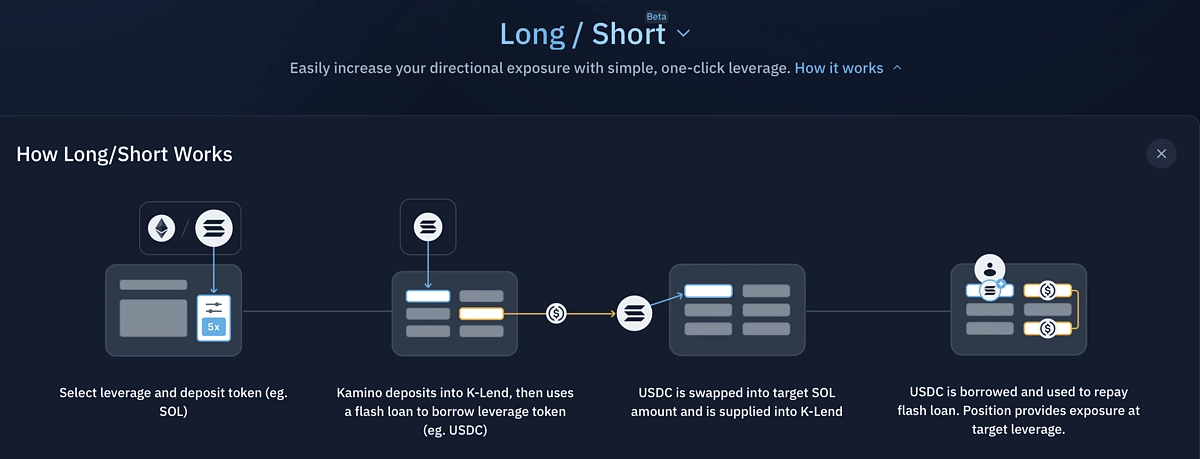
They work like any other long/short mechanism but with the added advantage of Kamino Finance's capabilities. Here's how you can long/short:
Step 1: Select Leverage and Deposit Token
Choose the amount of leverage you want to apply to your position (represented by 5x in the image). This means you'll be borrowing 4x your deposit amount to increase your exposure.
Now, select the deposit token (e.g., SOL) that you'll use as collateral.
Step 2: Kamino Deposits into K-Lend
Kamino takes your deposited SOL and puts it into K- Lend, Kamino's lending protocol.
Step 3: Flash Loan to Borrow Leverage Token
Kamino uses a flash loan to temporarily borrow an amount of USD Coin (USDC) equivalent to 4x your initial SOL deposit (because of your 5x leverage). Flash loans are a DeFi mechanism that allows you to borrow funds without collateral, on the condition that you repay the loan within the same transaction.
Step 4: USDC is Swapped into Target Asset (SOL)
The borrowed USDC is then swapped into the target asset you want to go long or short on (e.g., SOL in the image).
Step 5: USDC is Borrowed and Used to Repay Flash Loan
The swapped SOL is then used to borrow USDC from K-Lend. This borrowed USDC is used to repay the initial flash loan.
Key Features of Kamino Finance
One of the USPs of Kamino Finance is its easy to use product suite which offers transparent analytics, performance data details, as well as a comprehensive position information. Here are some of the key features of Kamino Finance:
-
Capital Efficiency: By enabling liquidity providers to pivot their assets on specific price ranges, Kamino Finance optimizes capital efficiency. This specific methodology ensures that the provided liquidity can be utilized strategically to meet market demand.
-
Low Slippage: Slippage increases when there is low market liquidity or high volatility. However, concentrated liquidity layers help lower slippage for traders. This feature enables users to mitigate risks and carry out trading services at more favorable prices.
-
Dynamic Range Positioning: Liquidity providers can dynamically adjust their position within the price range based on market circumstances. Thus, dynamic range positioning helps in providing flexibility to changing trading patterns and volatility.
-
Incentive Mechanisms: The platform offers incentive mechanisms including yield farming and governance tokens to attract and retain liquidity providers. Users providing liquidity to Kamino are rewarded.
-
Decentralized Governance: Users can actively participate in the decentralized decision-making process. This ensures that the protocol evolves in a way that aligns with the interests of its community.
Kamino Finance and Meteora: Advancing DeFi on Solana
1/ Excited to announce that, moving forward, Kamino will be collaborating with @MeteoraAG on a range of product integrations
— Kamino (@KaminoFinance) December 15, 2023
To kick off, we'll be exploring new liquidity strategies via DLMM vaults on Kamino, while Kamino Lend will be integrated into Meteora Vaults
🧵 pic.twitter.com/o6Ka8HmP3N
Kamino utilizes Meteora's DLMM and dynamic pools to create improved strategies for liquidity providers (LPs) in their vaults. This would ultimately increase liquidity within the Solana ecosystem by inviting more users.
Liquidity providers on Kamino can choose the strategy that best suits their needs by selecting a relevant Meteora-based vault. This offers flexibility and potentially higher returns.
The collaboration between Kamino Finance and Meteora aims to achieve the following:
-
Enhance returns for LPs by offering optimized liquidity strategies and reward programs.
-
Boost liquidity in the Solana ecosystem by attracting more users to participate in DeFi activities.
-
Create a more user-friendly DeFi experience with Kamino managing positions and Meteora providing efficient liquidity solutions.
Meteora's DLMM algorithms continuously analyze market conditions and automatically adjust the allocation of vault assets across different liquidity pools. This helps to:
-
Optimize returns: By strategically moving assets between pools with varying yields, Kamino aims to maximize returns for vault depositors.
-
Minimize impermanent loss: Impermanent loss is a risk associated with liquidity provision, where the price difference between deposited assets can cause potential losses. DLMMs can help mitigate this risk by adjusting pool allocations based on price movements.
How to Get Started with Kamino Finance
Follow these easy steps to navigate through the world of Kamino Finance:
Step 1: Visit Kamino.Finance and Connect Wallet

Set up a Solana-compatible wallet, like Phantom, and make sure the wallet is funded with SOL to carry out activities on Kamino Finance. We suggest connecting a wallet with a balance of at least 0.15 SOL.
Upon clicking the Connect button, Kamino Finance will request the following:
-
View your wallet balance & activity
-
Request approval for transactions
Step 2: Choose a Product/Service

After connecting your wallet, choose from the list of options in the header navigation bar. For illustration purposes, we will go ahead with Liquidity.

Liquidity allows you to deposit assets in a liquidity pool of your choice. Navigate through the available pools and markets to get an overview of the assets you can interact with.
Step 3: Deposit Assets
To deposit assets in a liquidity pool, you require both tokens that make up the liquidity pool. In case you do not have both the tokens, Kamino Finance will perform the swap on your behalf – this is called Single Asset Deposit.
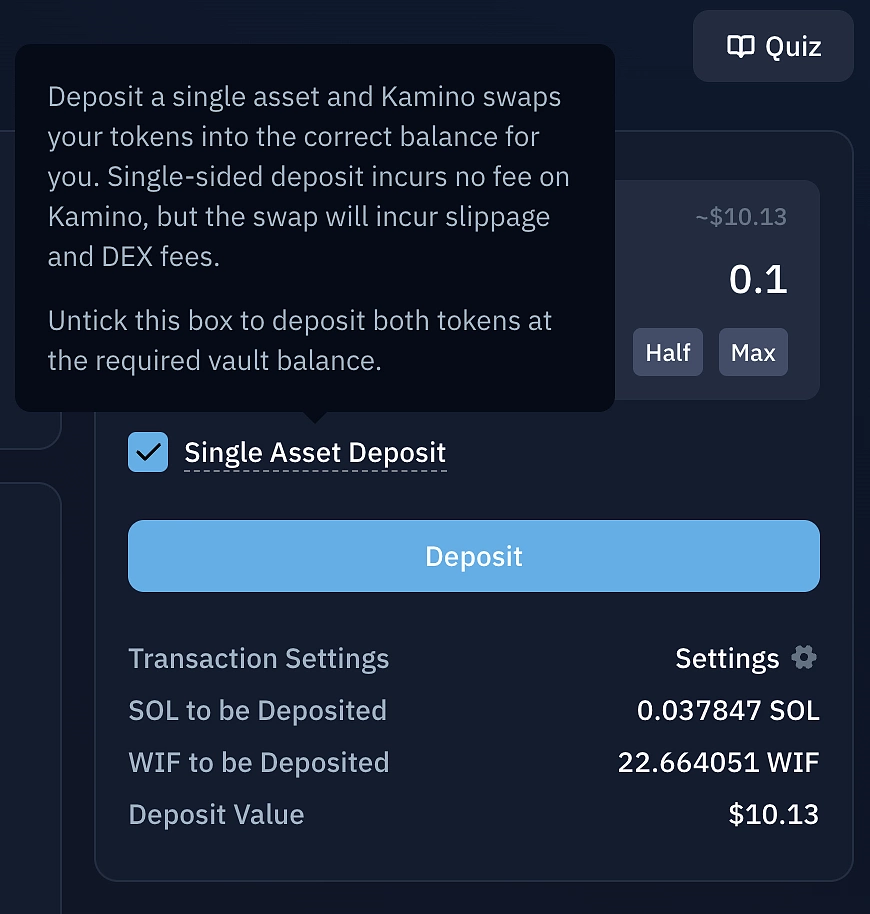
Here, we’ve chosen a WIF-SOL liquidity pool with Single Asset Deposit. So, Kamino Finance will automatically swap the appropriate amount of SOL to WIF.
After depositing, you will receive kTokens. In this case, kWIF-SOL tokens. Think of this as a receipt of your share in the pool.
Step 4: Earn Yield and Exit
You will now begin earning yield from your deposits. Be mindful of impermanent losses and other opportunity costs.
To exit your position, choose Withdraw from the drop-down menu.
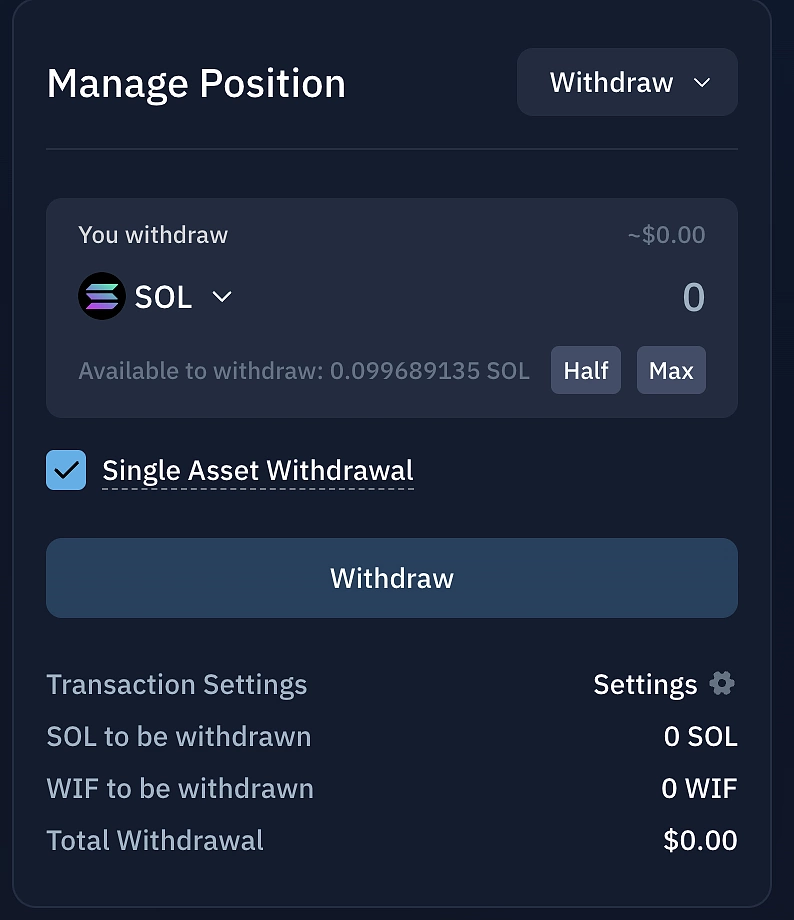
Here, you can choose Single Asset Withdrawal (either SOL or WIF, in this case) or un-check the box to withdraw the assets in a specific ratio.
Introducing Kamino Points: An Airdrop Opportunity

Kamino Points are a unique aspect of the Kamino Finance ecosystem, serving as a reward mechanism. By offering rewards and incentives, Kamino aims to acquire new users, reward loyalty, and also present valuable products to the community.
Kamino Points is a system that allows users to earn points at the foundational level of the protocol’s usage. Kamino Points let users implement different points rates and powers collateral assets, debt asset, collateral/debt combinations, liquidity vaults, automated strategies such as long/short and leveraged staking.
These points will dictate how many KMNO tokens, the native token of Kamino Finance, will be airdropped to each user. The KMNO token will also serve as the protocol's governance asset, where its holders will influence incentive programs, revenue allocation, and risk management operations within the Kamino ecosystem, according to a tweet from Kamino.
This system is also applicable for activities beyond Kamino and boosts actions taken on other Solana protocols, or assets like NFTs, LP tokens available in users’ wallets.
How to Earn Kamino Points?
Users can earn Kamino Points by actively participating on Kamino platform in these ways:
-
By providing liquidity to eligible pools. The greater the liquidity contribution, the higher would be Kamino Points rewards.
-
By engaging in trading activities within Kamino finance that are based on their trading volume. Kamino incentivizes active participation and contributes to the overall liquidity of the platform.
-
By participating in yield farming programs. Users can earn extra Kamino Points by staking LP tokens or Kamino Points in specified farms.
-
By actively engaging in governance decisions, users can earn Kamino Points as a reward for their contribution.
Users can check how much Kamino Points they’ve earned here.
Note that KMNO will be distributed via multiple airdrops across several months in late Q1 or early Q2 2024, with the first one slated for April.
Conclusion
Kamino Finance has emerged as a promising dApp on the Solana blockchain. Providing liquidity in DeFi can be complex, especially when considering the best strategies to maximize returns and minimize risks like impermanent loss. Kamino Finance simplifies this process by offering automated tools and strategies.
Over the years, DeFi has evolved to offer more than just simple trading and liquidity provision. Kamino’s integration of lending and leverage within the same platform empowers users with more financial tools and strategies.
Additionally, incentive mechanisms like Kamino Points foster user engagement and loyalty, which is essential for the growth and sustainability of any DeFi platform.

Sankrit is a content writer and a subject matter expert in web3. He has worked with notable companies, including Ledger, Alchemy, and MoonPay. Sankrit specializes in helping web3 brands create content that is easy to understand while accurately explaining technical concepts.



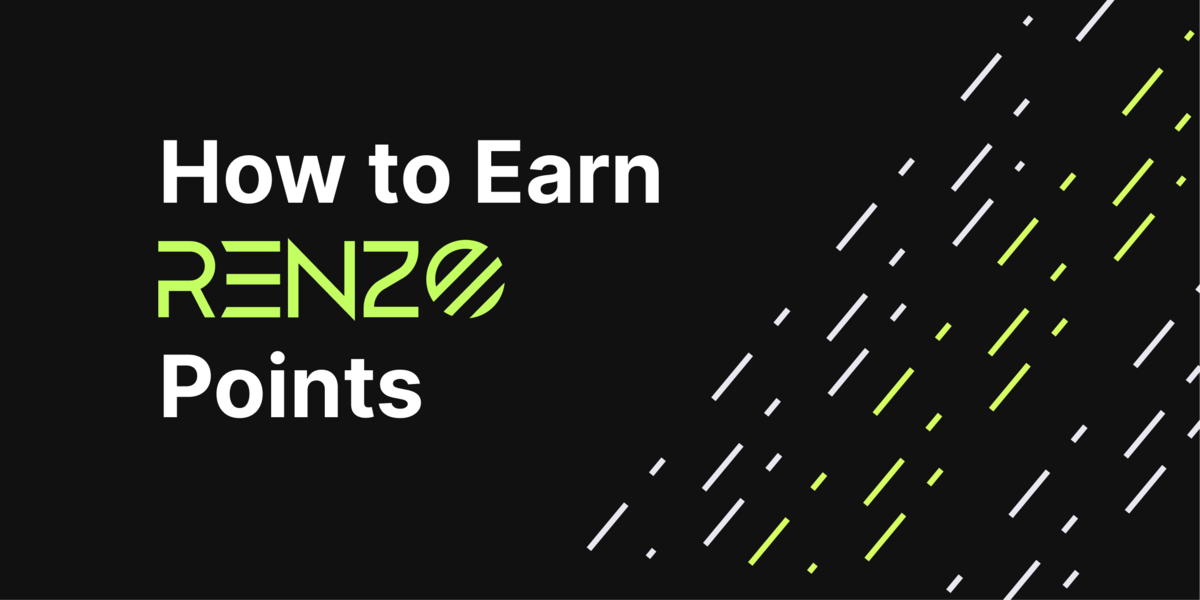





 Or check it out in the app stores
Or check it out in the app stores